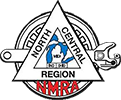If you did not already guess, the name of our convention, Station No.VI, is a play on the host city name of Novi Michigan. Many stories exist on how Novi got its name. Some believe the name is related to the train station which was the sixth station (roman number VI) from the end of the line in Detroit. This is our favorite, but what are the other stories of how Novi got its name? It is one of Novi’s biggest mysteries.
Barbara G. Louie, former member of the Novi Historical Commission, notes “there are at least nine different versions as to what the name really means and from where it originated.” Among these stories is the most popular, and, seemingly most logical, that the sixth township (NoVI) in the southwest portion of Oakland County was adapted by merely writing it out as one word: “NOVI.” A similar tale of equal popularity, albeit not as logical, has the town named after TollGate No. VI on Grand River (or the old Detroit-Howell) Road. Unfortunately for this theory, the toll road was not built for another twenty-two years after the town was already named. Speculation also includes the supposed date of the meeting that may have lent itself to the name, Nov. 1, as well as the humorous anecdote regarding the blacksmith-preacher whose wife’s name was Vivian, or “Vi” … The blacksmith-preacher was most awfully tight and forever vetoed any spending suggestions from his wife… It was always “No Vi” to anything until his place was referred to by the whole neighborhood as, “down to No Vi’s” then as “No Vi’s Corners,” and then just plain, “Novi.” The name is so controversial, the City of Novi made a video about it.
Railroad History
Novi railroad heritage is deeply routed in the Pere Marquette Railroad. The original railroad was built as the Holly, Wayne and Monroe Railway in 1870-72 between Holly and Monroe Michigan. In 1872 the Holly, Wayne and Monroe Railway was absorbed into the Flint and Pere Marquette Railroad. When the railroad was built through Novi in 1871, a station and storage depot were built where the tracks crossed Grand River Avenue, giving Novi farmers and merchants a way to send and receive large volumes of goods. Built in the 1850s, Grand River Avenue was an important route between Detroit and Lansing, until the railroad arrived, transportation was limited to horseback, wagon or stagecoach. Once the railroad arrived, this junction became a very import station stop for freight and passengers.


The railroad operated as the Flint and Pere Marquette Railroad until 1899 when the Chicago and West Michigan and the Detroit, Grand Rapids and Western railroads were consolidated and named the Pere Marquette Railroad (PM). The PM also acquired the Saginaw, Tuscola and Huron Railroad in 1900 making the PM the largest railroad (trackage miles) in Michigan. The PM mainlines stretched from Buffalo, NY to Chicago, IL and from Toledo OH to the far reaches of cherry country in Northern lower Michigan. One of the PMs most lasting legacies is the Lake Michigan ferry service from Ludington to points in Wisconsin allowing shippers to avoid the notorious delays in the Chicago area. The 410ft. S.S. BADGER (built under C&O control) is still plying the waters of Lake Michigan after 70 years of operation, although today it just ferries auto traffic and not railcars.


On August 10, 1946, the PM moved to upgrade its passenger service by introducing the streamlined passenger train “Pere Marquette” between Detroit’s Fort Street Union Depot and Grand Rapids Union Station. Pullman-Standard delivered two lightweight seven-car consists enabling three daily round trips. Each set consisted of a baggage/mail car, baggage car, two chair-observation cars, two chair-lounge cars, and a dining car. The train seated 220 in the four chair cars, and had space for 44 in the dining car. New EMD E7 diesel locomotives pulled the trains. The trains covered the 153 miles (246 km) between Grand Rapids and Fort Street Union Depot in Detroit in under three hours. Connecting service to Chicago was available in Grand Rapids. The name Pere Marquette continued to be used by the C&O until Amtrak took over in 1971. The name was again revived in 1984 when Amtrak resumed Grand Rapids-Chicago service.

The PM continued operations until June 5, 1947 when it was absorbed by the Chesapeake & Ohio Railway (C&O) which eventually became CSX. The full story of the PM is one of great highs and lows. From humble beginnings and the great lumber trade in Michigan to expansion and growth with the automotive revolution. The article Pere Marquette Railway by american-rails.com is a great starting point for additional information.
The depot in Novi still exists to this day although it was damaged by fire in 2021 and its future is in doubt at this time. It is believed the current structure dates back to the original 1871 Holly, Wayne and Monroe station. If you find time to visit the depot, it is hidden near the modern highway bridge that lifts Grand River over the current CSX right of way. A historical marker is present which provides some history to the station and the areas railroad heritage.



